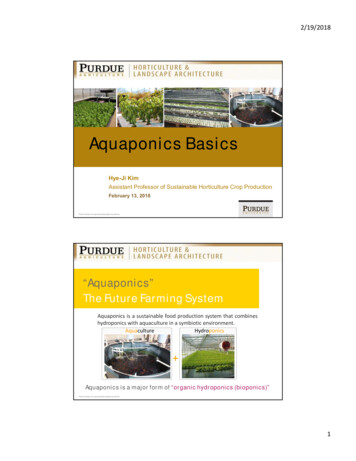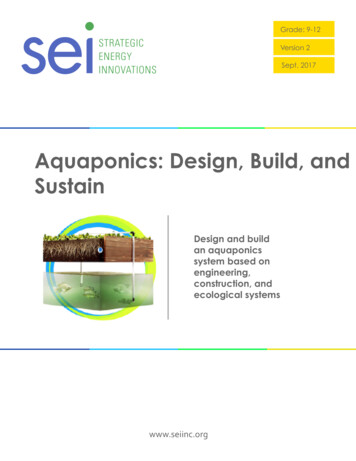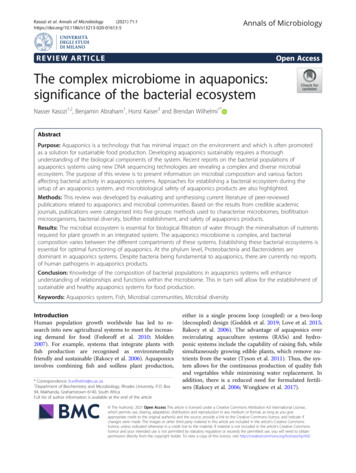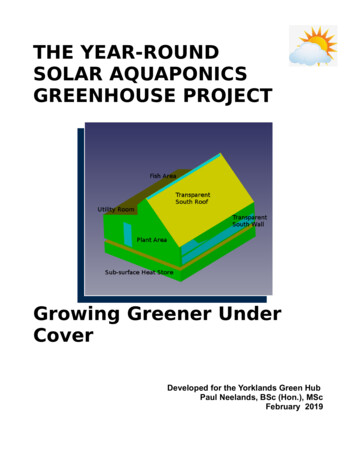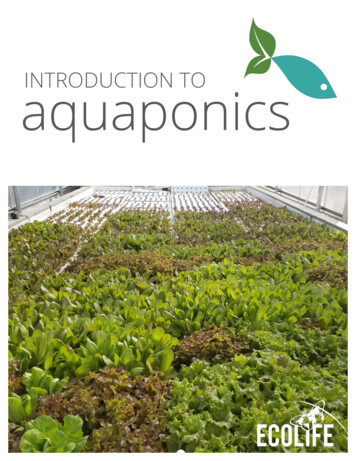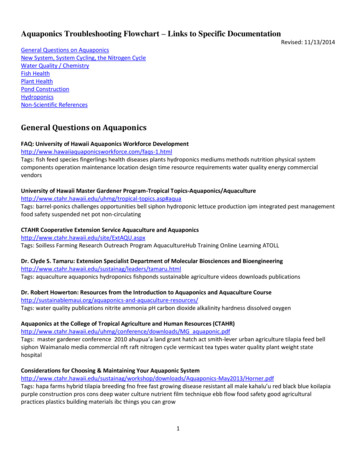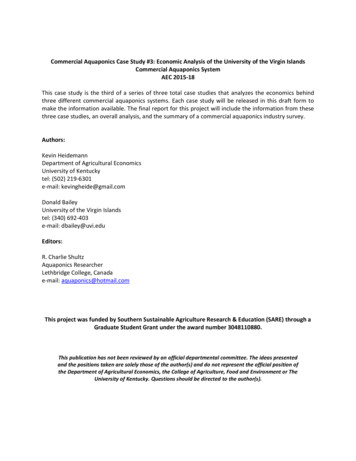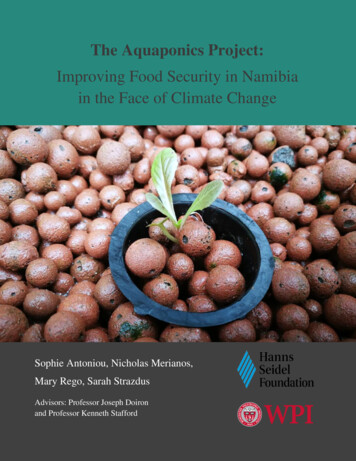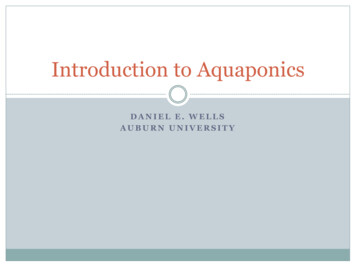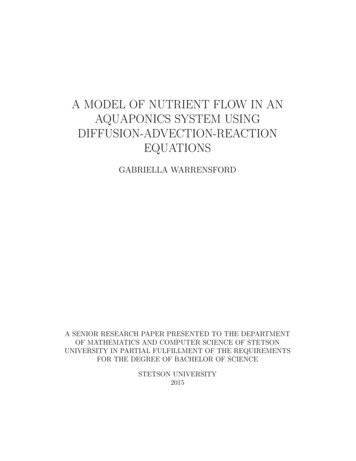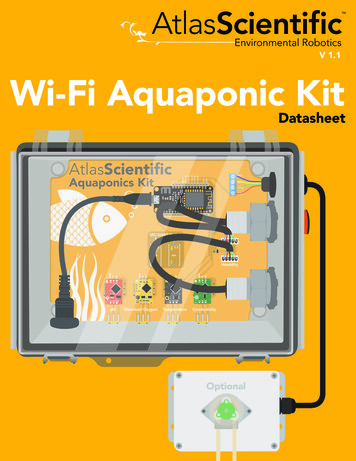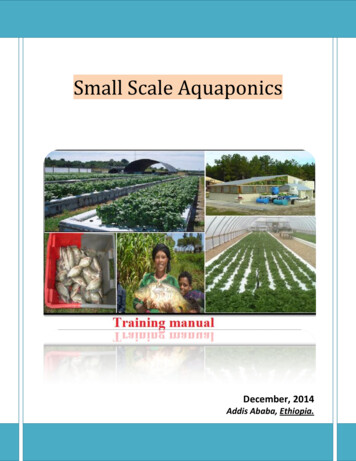
Transcription
Small Scale AquaponicsDecember, 2014Addis Ababa, Ethiopia.1 Page
AbstractThis training manual defines aquaponics and provides short brief towards its developmentalhistory on the introductory part. It discusses the main theoretical concepts of aquaponics, theaquaponic systems including placement of aquaponic garden, how aquaponics works, theweaknesses and strengths of the system. The manual then entails about the design andconstruction of the system which focuses mainly on the selection of appropriate site, unit design,the important components of an aquaponic unit, system set up, aquaponic plumbing and systemstart. This training manual discusses in detail the three groups of living organisms (bacteria,plants and fish) that make up the aquaponic ecosystem.The manual incorporates also briefs on other issues like the possible sources of water foraquaponics in Ethiopian context, production of plants and animals in an aquaponic system andnutrients and fertilizers required to cultivate them.Finally the manual presents the unit management practices necessary to run an aquaponicsystem. In this part the necessary calculations in aquaponics, pests and pest control, energysources for aquaponics, and solutions for commonly facing problems are discussed.2 Page
Table of ContentsAbstract . 21.2.Introduction . 71.1.Definition . 71.2.Developmental history of aquaponics . 71.3.Aquaponic unit Cycles . 91.3.1.System cycle . 91.3.2.Nitrogen cycle . 91.4.Benefits of aquaponics . 101.5.Limitations of aquaponics . 13Aquaponic Systems . 132.1.Locating Aquaponic garden . 152.2.How aquaponics works . 172.3.Types of Aquaponic Systems . 182.3.1.Raft Based . 182.3.2.Media Based systems . 202.4.2.4.1.Purpose of Grow Media . 232.4.2.Selection of grow media (substrate) . 242.5.3.4.The Grow media (Substrate) . 23Strength and weakness of aquaponic systems . 26Design and Construction of the systems . 273.1.Site selection . 273.2.Aquaponics unit design . 273.2.1.Necessary materials and facilities . 273.2.2.Greenhouse Design . 283.3.Components of aquaponic systems . 293.4.System Setup . 303.5.Aquaponic Plumbing . 323.5.1.Plumbing fluid dynamics . 333.5.2.Important Parts in Plumbing . 343.5.3.Fitting pipes through the growbeds. 363.6.Aquaponic System Configuration . 363.7.Aquaponic System Starting. 42Sources of Water and Water Quality . 444.1.Water sources for Aquaponics . 453 Page
5.4.1.1.Town or Municipal water . 454.1.2.Rain water . 464.1.3.Cistern or aquifer water . 464.2.Importance of water quality . 464.3.Tolerable water quality parameter ranges . 474.4.Water quality parameters to be considered . 474.4.1.Oxygen (DO2) . 474.4.2.Water temperature . 484.4.3.pH (power or potential of Hydrogen) . 494.4.4.Nitrogen . 504.4.5.Water hardness . 524.5.Measures to manipulate water quality . 534.6.Threats in water quality. 544.6.1.Algal bloom . 544.6.2.Parasites . 55Nutrients and Fertilizers. 555.1.5.1.1.Macro nutrients . 555.1.2.Micronutrients . 575.2.6.Fertilizers . 585.2.1.Nitrogen . 595.2.2.Phosphorus . 595.2.3.Potassium . 60Fish Production . 616.1.Fish suited to aquaponics . 626.1.1.Tilapia . 626.1.2.Carp fishes . 626.1.3.Catfish . 636.2.7.Nutrients. 55How to produce fish . 636.2.1.Fish feed and nutrition . 646.2.2.Water quality tolerances for fish . 686.2.3.Stocking fish . 686.2.4.Fish health and diseases . 68Bacteria . 727.1.Starting up (Cycling) aquaponic system . 734 Page
7.1.1.Cycling with Fish . 757.1.2.Fishless Cycling . 767.2.7.2.1.Adding bacteria . 797.2.2.Sources of bacteria. 797.3.How bacteria are working . 797.4.Other organisms; worms . 807.5.Importance of bacteria and worms . 817.5.1.Roles of Bacteria . 817.5.2.Roles of worms. 827.6.8.Unwanted bacteria . 837.6.1.Sulphate reducing bacteria . 837.6.2.Denitrifying bacteria . 837.6.3.Pathogenic bacteria . 84Vegetable Production . 858.1.9.Bacteria involved . 78Plants suited to aquaponics . 858.1.1.Salad varieties . 868.1.2.Vegetables. 878.1.3.Herbs . 878.1.4.Companion plants . 878.2.Growing systems . 888.3.Nutrient deficiency and toxicity . 88Aquaponic Unit Management . 919.1.Initial stage aquaponic unit management . 919.2.Aquaponic calculations . 929.2.1.Ratios of Fish to Plants . 929.2.2.Water budgeting . 939.3.Pests in Aquaponics . 949.4.Pest control. 949.4.1.Beneficial Insects. 959.4.2.Biological Sprays. 979.4.3.Synthetic Chemical Pesticides . 989.5.Sources of energy for Aquaponics . 999.5.1.Solar energy . 999.5.2.Biogas energy . 995 Page
9.5.3.9.6.Wind energy . 100Regular Follow ups in aquaponics . 1009.6.1.Daily management Practices . 1009.6.2.Weekly management practices. 1009.6.3.Monthly Activities . 1009.7.Solutions for commonly facing problems . 101Annexes . 103Annex 1- Summary of selected issues . 103Annex 2 - Feed requirement for important fish species . 108Annex 3 - List and relative amounts of ingredients for 10 kg of fish feed . 108Annex 4 - Step-by-step preparation of homemade fish feed. 109Annex 5 - Practical system design guide for small-scale aquaponic units. 110Annex 6 - Ten key guidelines for successful aquaponics . 111Annex 6 - List of important materials and tools . 112Annex 7 - Preparing the Intermediate bulk container (IBC) fish tanks . 1186 Page
1.Introduction1.1.DefinitionAquaponics is a method of food production that combines aquaculture; the cultivation of aquaticanimals such as fish, shrimp, crayfish, or prawns, in tanks and hydroponics; the growing ofplants in water. Ponos is a Greek word meaning growing plants with or without media. Mostpeople relate growing plants to hydroponics since both use nutrient rich water and both use soilless media. The fish and plants are cultivated together in a recirculating ecosystem that utilizesnatural nitrogen-fixing bacteria to convert fish/aquatic animal wastes into plant nutrients. Thewaste products of the aquaculture system serve as nutrients for the hydroponic system. With sucha combined recirculating system, there is no need to discard any water or filtrate or add anychemical fertilizers, making it both sustainable and environmentally friendly.In a traditional aquaculture system, animal waste byproducts (in the form of ammonia) build upover time and become toxic to the animals being cultivated; as a result, 10 to 20% of the totalvolume of water must be discharged and replaced every day. However, in an aquaponic system,the water produced from the aquaculture portion of the system is fed into the hydroponic portionof the system, where plants are grown with their roots immersed in the effluent (waste) water.The ammonia in the effluent water is converted by bacteria into nitrites and then nitrates, whichare used by the plants as nutrients. Basically, aquaponics is an integrated system that utilizes thebest attributes of both aquaculture and hydroponics while eliminating some of the challengesassociated with each of these systems.1.2.Developmental history of aquaponicsWhile most people know that Aquaponics is the combination of Aquaculture and Hydroponics,rather fewer know much of how it came about. The notion of using fish wastes to fertilize plants(the fundamental premise of aquaponics) has its roots in early Asian and South Americancivilizations. The ancient Aztecs built ‘chinampas’ (networks of canals and stationary artificialislands) in which they cultivated crops on the islands using nutrient-rich mud and water from thecanals.7 Page
The New Alchemists are probablythe people principally responsiblefor Aquaponics. In 1969, John andNancy Todd and William McLarneyfounded the New Alchemy Institute.The culmination of their efforts wasthe construction of a prototypeagricultural “Ark” a solar-powered,self-sufficient, bio-shelter designedto accommodate theyear-roundneeds of a family of four using holistic methods to provide fish, vegetables and shelter.In the mid 1980’s, Mark McMurtry (graduate student) and Doug Sanders (Professor) at NorthCarolina State University (NCSU) created the first known closed loop aquaponic system.Effluent from fish tanks was used to trickle-irrigate tomatoes and cucumbers in sand grow bedswhich also functioned as bio-filters. The water drained from the sand grow beds was recirculated back into the fish tanks. McMurtry’s research and findings confirmed much of thebackground science that underpins Aquaponics.In the early 1990’s, Missouri farmers Tom and Paula Speraneo modified the NCSU system andintroduced their Bioponics concept. They grew herbs and vegetables in ebb and flow gravel growbeds irrigated by the nutrient rich water from a 2200 litre tank in which they raised Tilapia.While gravel grow beds had been used for decades by hydroponicists, the Speraneos were thefirst to make effective use of them in Aquaponics. Their system was practical and productive andhas been widely duplicated by Aquaponics enthusiasts throughout the World.Americans Rebecca Nelson and John Pade commenced publication of their quarterly AquaponicsJournal in 1997. In more recent times, Canadian researcher Dr Nick Savidov has undertakenfurther research around the productive potential of aquaponics.8 Page
1.3.Aquaponic unit Cycles1.3.1. System cycleA. Fish are fed food and produce ammonia rich waste. Too much waste substance is toxic for thefish, but they can withstand high levels ofnitrates.B. Dissolved Oxygen enters the systemthrough an air pump. This Oxygen isessential for plant growth and fish survival.C. The bacteria, which are cultured in thegrow beds as well as in a fish tank breaksdown the ammonia into nitrites and thennitrates.D. Plants take in the converted nitrates as nutrients. The nutrients are fertilizers, feeding theplants. Also, the plant roots help filter the water for the fish.E. Water from the fish tank is pumped to the plants. Again water in the system is filtered throughthe grow medium in the grow beds to the fish tanks. The water also contains all the nutrients forthe fish.1.3.2. Nitrogen cycleFish excrete waste nitrogen as ammonia into thewater. Nitrifying bacteria then convert the ammoniacompound to nitrite and then nitrate. Both ammoniaand nitrite are toxic to fish, while nitrate is relativelyharmless and is also the preferred compound ofnitrogen for plant uptake. Nitrogen is not the onlyelement that can be recycled in this manner, Plantsare able to recover other nutrients from the waste water as well. This relieves the environmentalload and increases the water exchange rate, in turn lowering operational costs.9 Page
1.4.Benefits of aquaponicsWaste nutrients produced by fish or any aquatic animals are recovered by the plants.This eliminates the need to dischargewater into the environment andminimizes the need to exchangewater (other than topping off waterthat evaporates and goes into theplantbiomass).Comparedtotraditional aquaculture, aquaponicsystems use much less water, whichis especially attractive in arid, waterscarce regions of the country likeAfar. An aquaponic system uses only 1% of the water required in pond culture toproduce equivalent yields of tilapia.By minimizing the need to exchange water, overall operational costs are reduced. This isparticularly important in arid climates and in heated greenhouses where water or heatedwater can be a major expense.Because of the daily application of fish feed to the system, the plants receive a steadystream of nutrients, which eliminates the need to discharge and replace depleted nutrientsolutions, as would be the case in hydroponic systems.Unlike hydroponic systems or recirculating aquaculture systems, aquaponic systemsrequire substantially less water quality monitoring.The same media used to grow the plants also serve as the surfaces on which the nitrogenfixing bacteria grow. The plants being grown act as filters by removing the nutrientsfrom the effluent water. This eliminates the need for separate biofilters in most cases,which can be expensive.Plants grown in aquaponic systems receive most of their required nutrients at no cost,thereby improving the profit potential of the system.Finally, by producing two crops (vegetables and fish) with the same system, theoperational and infrastructural costs are shared, which increases the savings and profitmargins.10 P a g e
Some aquaponics enthusiasts are primarily interested in the plants they cultivate, andgrow fish or other aquatic animals simply to provide the low-cost nutrients to theirsystem. Others grow both plants and fish to sell or consume. Some growers cultureedible fish, while others grow ornamental fishes such as goldfish. The plants and animalsproduced are locally grown and pesticide-free (aquaponic systems normally operatewithout the use of pesticides because of the risk of killing the fish), and plants requirefew if any additional fertilizers.Compared to traditional soil methods of growing plants, significant reduction in theusage of water as all water is recycled through the system and it is not necessary todiscard or change any water (under normal conditions). It has been reported that waterusage is around 90% lower than traditional soil gardening.Growth of plants is significantly faster than traditional methods using soil. In aquaponicsthe plant roots are watered (flooded) at least once an hour in most system and haveconstant access to high levels of nitrates that are in the water.Aquaponics grown vegetables are bigger and healthier than when grown in soil.aquaponics systems look remarkably prosperous with big, vibrant and healthy fruit andvegetables.There is no need to use artificial fertilizer to feed the plants. In the perfect system this isprobably true though some aquaponics owners add "supplements" such as iron to theirsystem to compensate for non-ideal environments (e.g. high pH systems). Fertilizer inthe traditional sense is not used and indeed using fertilizer would likely harm or kill thefish. So there is probably a real cost saving over soil gardening in this area as there is noneed to be improve soil before planting or during plant growth.There is no need to dispose of fish waste or provide an artificial filtration system. In landbased aquaculture systems either water needs to be replaced or some filtration needs tobe provided to remove ammonia (fish waste) from the water. Filtration needs to beprovided for the same reasons in aquaponics systems - though in a lot of systems thefiltration serves as the medium to grow the plants and the plants remove the nitrates (lesstoxic to fish) from the system.11 P a g e
Significant reduction in land is required to grow the same crops as traditional soilmethods. As water and nutrients are constantly provided it should be possible to growplants close together with the main requirements for spacing being access to light.It's easier to setup for year round use compared to traditional gardening methods as growbeds are raised of the ground and growing area is compact allowing for economical"green house" type methods to be employed. It would be true in very cold climateswhere the ground freezes in winter though in many climates using ground temperaturescan help to moderate the temperature of water/media in the system.It is a source of organic vegetables, fruits and fish as the process needs to add any of theinorganic inputsCommercial setups have been used as tourist attractors in rural communities to providean additional revenue source.Reduced damage from pests and disease. No more soil pests hence the need forpesticides is eliminated, which makes it that much easier to have amazing plants andfruit without toxic chemicals.No labour requirement as there is no or less weeding. If there be bending down on theground is not required as the system uses growing beds.It grows most plants twice as fast since fish provides most nutrients required by plants.For example lettuce takes only about 29 days to mature with this system.Hydroponic component serves as a bio-filter. Hydroponic plants extend water use andreduce discharge to the environment.Integrated systems require less water quality monitoring than individual systems.Profit potential increased due to free nutrients for plants, lower water requirement,elimination of separate bio-filter, less water quality monitoring and shared costs foroperation and infrastructure.12 P a g e
1.5.Limitations of aquaponics Initially it is expensive to setup a commercial scale aquaponic unit as the systemrequires technical knowledge and inputs like pumps, tubing, and tanks or beds. It requires a green house if it is going to be established in cold areas so as to provideheat for the fish and the vegetables. A green house can be advantageous to provide heatin cold winters, protect the system from heavy rains and keep out pests, albeit this is alsotrue for soil based gardening. Aquaponics requires electric energy input to maintain and recycle water within thesystem. Electricity should be provided to run a water pump and possibly aeration pumpsas well to flood and drain our grow bed buckets. If one or more components fail this could lead to the loss of fish and or plants hence thesystem requires reliable technology In this system, it is mostly very difficult to grow root crops.2.Aquaponic SystemsProduction of vegetables without soil is a new science invented to produce plants without soil,hence called "soilless culture." Soilless culture by definition is the discipline of producingagr
This training manual defines aquaponics and provides short brief towards its developmental history on the introductory part. It discusses the main theoretical concepts of aquaponics, the aquaponic systems including placement of aquaponic garden, how aqua
